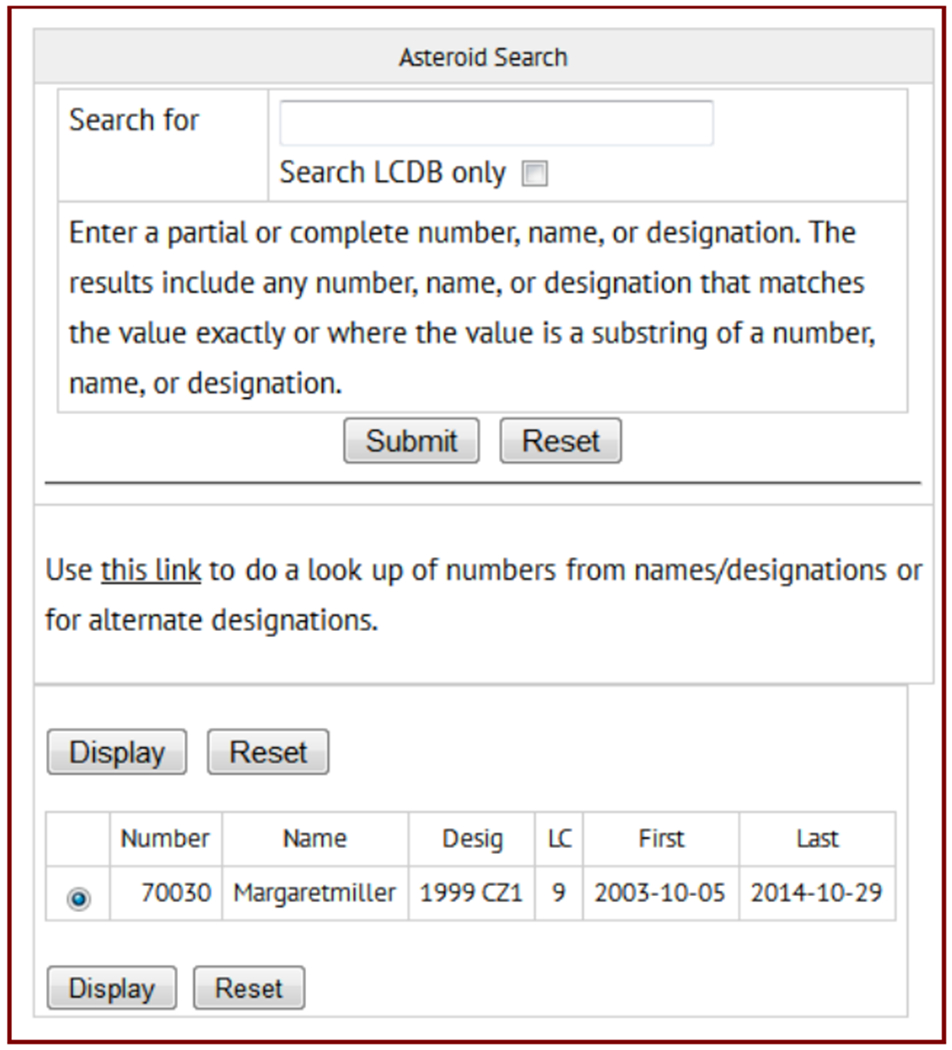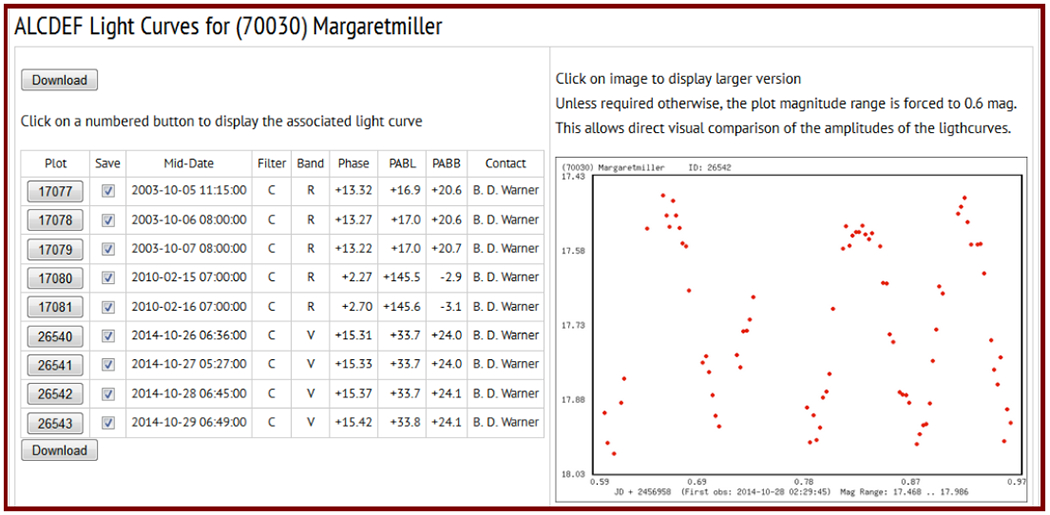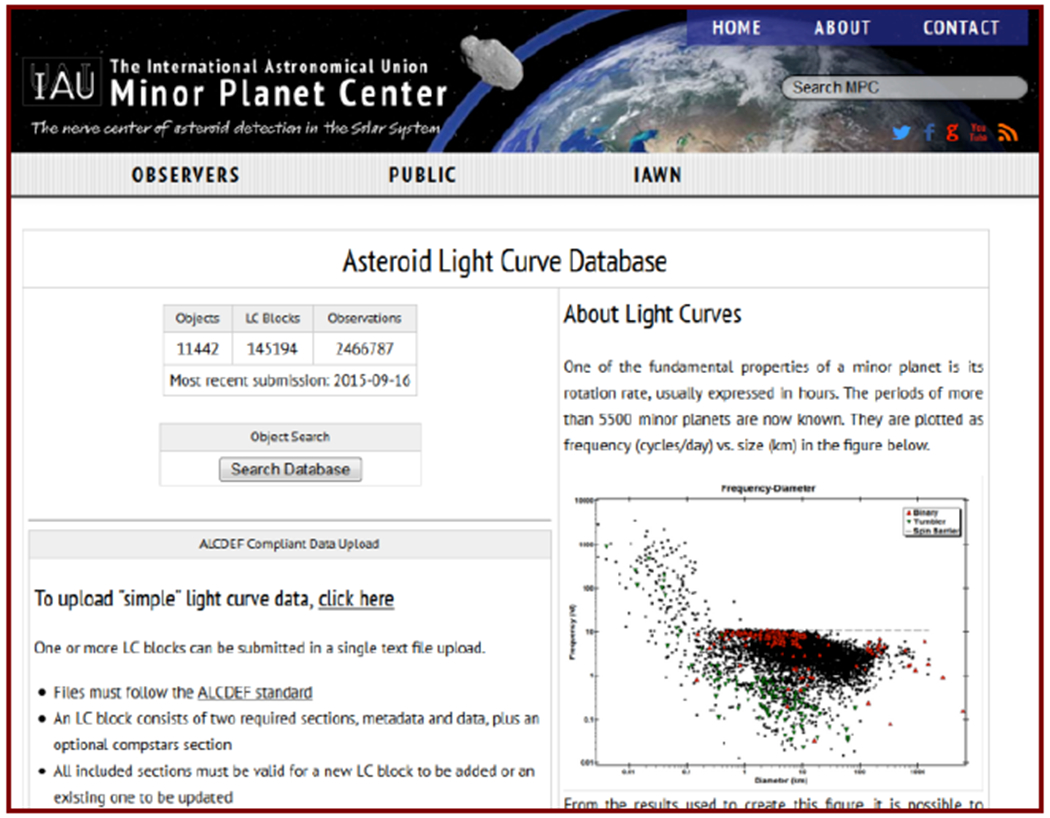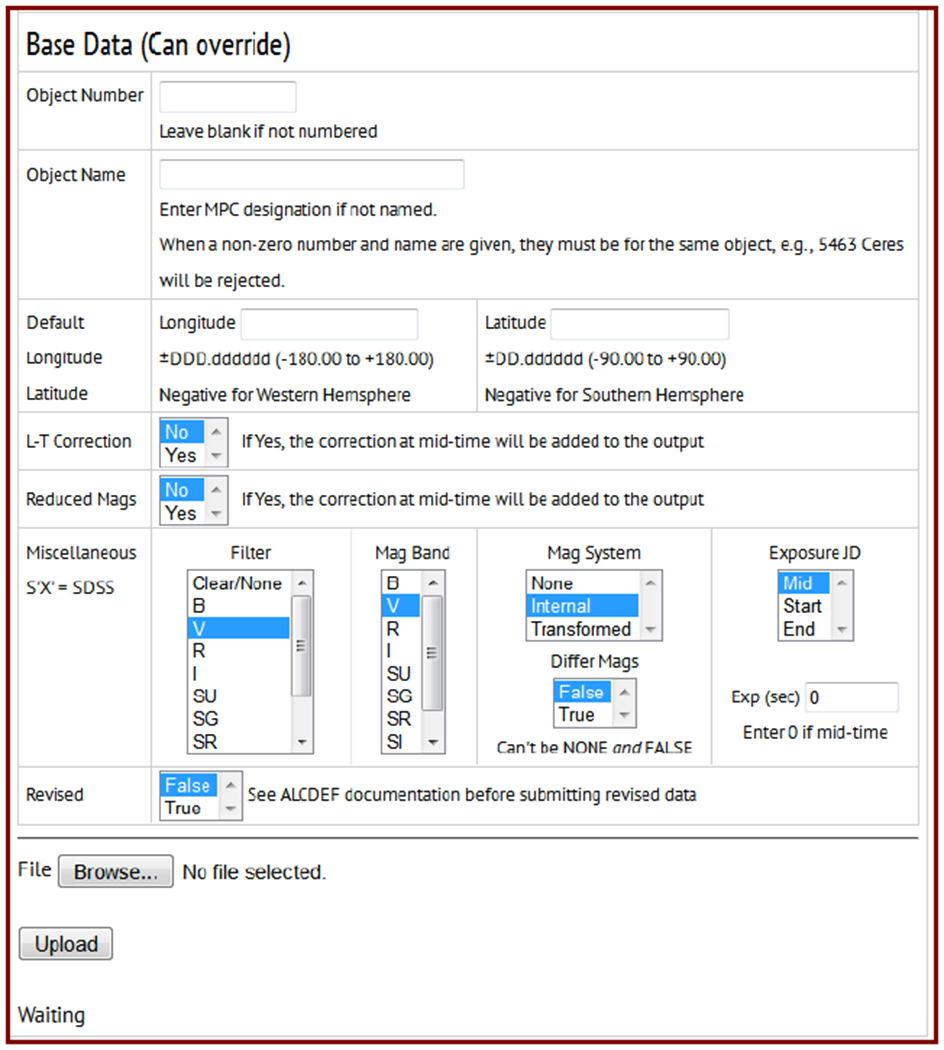Abstract
The Asteroid Lightcurve Data Exchange Format (ALCDEF) project has been in development for more than five years. To date, almost 2.5 million time-series data points for more than 11400 asteroids have been submitted to the ALCDEF database hosted on the Minor Planet Center web site. These raw time-series observations have helped researchers produce hundreds of shape and spin axis models. The recent introduction of the S-ALCDEF (Simple-ALCDEF) page is hoped to encourage that even more data be submitted and so expedite and facilitate research efforts that depend on these type of data.
A Brief History of ALCDEF
In the past decade, the number of asteroid lightcurves has grown almost exponentially, mostly due to the efforts of backyard astronomers and students working with small college observatories. Two recent papers involving professional surveys (Waszczak et al. 2015, Chang et al., 2015) added more than 10,000 lightcurves to the asteroid lightcurve database (LCDB; Warner et al., 2009).
The rotation periods derived from these lightcurves have helped change the picture of the Solar System dramatically by providing conclusive evidence of the YORP effect (Yarkovsky–O’Keefe–Radzievskii–Paddack; Rubincam, 2000), which is the thermal reradiation of sunlight that affects the rotation rates (e.g., Pravec et al., 2008) and spin axis orientations of asteroids (e.g., Hanus et al., 2013). The availability of the raw data that led to the lightcurves has also allowed a significant increase in the number of shape models (which include spin axis orientation). Beyond the mere curiosity of knowing the shapes of various asteroids, these models have also helped refine theories and ideas on YORP, asteroid densities, and binary formation mechanisms, among others.
These advancements are due in large measure to the availability of the underlying raw time-series data, which are required for the modeling process. However, there remains a fundamental issue: the lack of a universally-accepted, central repository similar to the one for astrometric data as managed by the Minor Planet Center. Without such a repository, a researcher may have to contact a number of people and scour several web sites in order to find all available lightcurve photometry. This can be a poor use of resources.
The idea of a central repository for asteroid time-series photometry is not new. Magnusson et al. (1993) made one of the earlier significant efforts towards this goal by outlining the Uppsala Asteroid Database, which stored time-series data going back to the 1950’s for hundreds of asteroids. The final version of this was produced by Lagerkvist et al. (1993). An update was done in 2011 (NASA, 2011) where the data lines were put into their own ASCII tables, apart from the metadata tables. However, not all data in the Uppsala catalog can be taken at face value.
While the 2011 update appears to have standardized all dates to be light-time corrected and magnitudes to unity distances using geo- and heliocentric distances, many other pitfalls are to be found. Quoting from the metadata table for one asteroid but which appears to be common to many if not all asteroids,
Some observation sets … may have an artificial Julian date, which may be set near 0.0, since the observation time is unknown or the lightcurve is a composite of several observation sets made at different times … Some observation sets have unknown constants added to their magnitudes.
In other words, some of the dates may be offsets from a zero point that are based on a presumed period that may be wrong. This is a critical problem when modeling since the asteroid-Sun and asteroid-Earth geometries are an essential element in the process. Having the wrong dates, especially if based on incorrect periods, will lead to bad models.
The issue with the magnitudes can be mitigated by using the values as relative magnitudes, not absolute, when modeling. However, for those data that are actually absolute, i.e., standardized apparent magnitudes reduced to unity distances, their value is diminished. The lightcurve inversion modeling process cannot constrain the z-axis of an xyz ellipsoid unless all the data are absolute. It might be possible to “unscrew” the catalog data into original data, but this may involve guess work or, at the very least, referring to the original paper, if available, to try to understand the data’s pedigree. This takes time, lots of time, which is a rare commodity for most researchers.
There was an attempt to extend the Uppsala Database with the Standard Asteroid Photometric Catalog (Piironen et al., 2001). That site does not appear to have been active for several years.
At the Division of Planetary Sciences meeting in 2010 (Stephens et al., 2010; Warner et al., 2011), a renewed effort for establishing a central repository was introduced along with a standardized reporting format: the Asteroid Lightcurve Data Exchange Format (ALCDEF). The critical elements of ALCDEF were that
Metadata and data were in a single, simple ASCII file (ASCII values < 128). Information for more than one observing run for a given asteroid and even multiple asteroids could be contained in a single file.
The format followed a “FITS-like” structure, i.e., keyword=value, including the photometric data.
The data were raw photometry, i.e., they were not reduced to unity distances nor were arbitrary offsets to magnitudes added, such as might be done during period analysis. In other words, if the data were not differentials from a common zero point, they represented the apparent sky magnitude of the asteroid at the time of the observation. If the magnitudes were offsets, then the common zero point could be indicated in a comment line.
The data used full Julian Dates for the mid-time of each observation. The J.D. were not offsets from an arbitrary zero point nor based on a presumed period (the S-ALCDEF standard – see below – allows importing partial or full JD or MJD values).
The metadata section included a number of required keywords, e.g., object number and name, mid-date of observations, data set contributor name and contact information, etc. The standard also included a number of optional keywords that would further define the data for use by other researchers.
Initially the data were stored on a public web site maintained by the author but this was not an adequate long-term solution. A conversation in 2009 with then MPC Directory Timothy Spahr eventually led to a web page on the MPC site in 2010 that was developed by MPC staff member Michael Rudenko with the assistance of Assistant Director Gareth Williams.
In 2014, the author began work with MPC staff members Dr. Jose-Luis Galache, Jim Davies, and Michael Rudenko to produce a new version of the web site that would be developed by the author using PHP code and MySQL database. The new code would include additional cross-checks of incoming data to assure its quality and avoid contradictions, e.g., trying to submit data for (8132) Vesta. Data retrieval of only newly added objects or a subset of lightcurves was another enhancement to the original site. The new site is now available at
As of mid-September 2015, the ALCDEF database included almost 2.5 million individual observations for more than 11,400 objects. This includes the raw data from the Waszczak et al. (2015) paper that used sparse photometry (about 50-75 data points on 4 nights).
The home page calls it the “Asteroid Light Curve Database.” Unfortunately, this is the same name given to the database of rotation periods commonly referred to as the LCDB (Warner et al., 2009). The author and MPC are working on resolving this conflict. Until that happens, to avoid confusion, this database should be referred to as the ALCDEF (pronounced ALK def) database.
The ALCDEF home page allows the user to
Search the ALCDEF and/or LCDB databases by number, name, or designation.
Upload data files to the ALCDEF database.
Download the latest full archive or only data added since the last full archive. The full archive is updated approximately every three months.
Figure 2 shows the search page after searching for ‘70030’. Only one result was found and was eventually selected. The case-insensitive search will find embedded strings as well. For example, if the search had been for ‘Fred’, the list would contain, among others, 678 Fredegundis and 1575 Winifred. The default is to search and display matching records in the ALCDEF database. If no ALCDEF matches are found, the LCDB is searched independently. It is possible to search only the LCDB by checking the “Search LCDB only” box.
Figure 2.

The search page after looking for an asteroid number of 70030.
Referring to Figure 2, if no matching object exists in the ALCDEF tables but does in the LCDB, then the list will include only the number, name, and MPC designation. If there is at least one matching object in the ALCDEF database, the last three columns give the number of lightcurves and the earliest/latest observation dates. When an ALCDEF object is selected and the user clicks the <Display> button, an LCDB search is done and, if the object is found, the LCDB information will be included in the display page.
Figures 3 and 4 show screen shots of the results for 70030 Margaretmiller (the author’s wife). This asteroid was in the ALCDEF and LCDB tables. In Figure 3, the list of available “lightcurve blocks” is shown. Clicking on a numbered button plots the data in the lightcurve block. All plots are forced to a magnitude range of 0.6 mag, unless the data for a given block exceed that range. This allows a direct visual inspection of the amplitude changes at different viewing aspects.
Figure 3.

A screen shot showing the ALCDEF entries for asteroid 70030 Margaretmiller.
Figure 4.

This partial screen shot shows some of the entries from the LCDB for 70030 Margaretmiller.
Below the lightcurve is a plot (Figure 5) showing the phase angle bisector longitude of the chosen block as a red symbol while any other blocks are displayed with grayed symbols.
Figure 5.

The phase angle bisector longitude (LPAB) plot shows the value for each of the available lightcurves. The values are ecliptic longitude with 0° being the Vernal Equinox.
This feature allows an observer to check if the phase angle bisector longitude (LPAB) at the time of new observations will differ significantly from previous data sets; this would make them even more useful for modeling. However, even if the observations are near existing LPAB values, they may extend the total date range of observations and so help refine the sidereal rotation period. That, in turn, could lead to determining if the asteroid’s rotation period is changing, which a signature of YORP.
Clicking on a lightcurve or LPAB plot displays a larger version. This is a PNG file that can be saved, typically using the browser’s “save image as” popup menu item.
After checking the boxes next to the lightcurve blocks for which data are wanted, clicking the <Download> button generates an ASCII file in ALCDEF form that can be saved to a local computer.
Figure 4 shows a partial screen shot of the LCDB entries for 70030 Margaretmiller. Clicking on the BibCode reference in a given line opens a new window and takes the user to the SAO/NASA ADS page for that reference where, in many cases, the original paper is available for download.
Further Encouragement – S-ALCDEF
To upload data from the main ALCDEF page requires that the metadata and data follow the ALCDEF standard. Programs such as MPO Canopus, written by the author, include provisions for writing such files from the original data. However, many other programs do not and there is a wealth of legacy data that might also be uploaded if there were a simpler format.
In mid-2015, the Simple-ALCDEF (S-ALCDEF) standard was introduced by the author. In its simplest form, S-ALCDEF requires only four lines other than the data lines. For example, assuming all the data in the file are for the same asteroid (bold text highlights the four lines),
#First night
STARTBLOCK
STARTDATA
2457210.698517|+18.377|+0.121
2457210.700769|+18.489|+0.136
2457210.703026|+18.354|+0.121
…
ENDDATA
ENDBLOCK
#Second Night
STARTBLOCK
STARTDATA
2457210.776946|+17.375|+0.055
2457210.777695|+17.419|+0.058
…
ENDDATA
ENDBLOCK
Lines preceded by the hashtag (#) are ignored. The hashtag can also be embedded in a line. Starting with the hashtag, it and all characters after it on that line are ignored, making it possible to include a comment about a specific line in the file.
Of course, the system must know for which object the data apply and this is provided in one of two forms on the S-ALCDEF page,
http://www.minorplanetcenter.net/light_curve2/alcdef_SimpleUpload.php
The “Required Data” form applies to all lightcurve blocks. This includes the submitting author’s name and contact information and the delimiter character between fields in the data lines. A universal comment of up to 400 characters can also be included.
The “Base Data” section includes default entries for every lightcurve block, unless a specific block overrides one or more of the entries. The overrides are applied only to the block in which they are found; the remaining defaults from the form are applied to the block. An example of this would be when the object changes. For example,
#First asteroid
STARTBLOCK
OBJECTNUMBER=1
OBJECTNAME=Ceres
…
#Second asteroid
STARTBLOCK
OBJECTNUMBER=70030
The override lines must use the full ALCDEF standard keyword and provide data in the form and format expected. There are many themes and variations allowed. However, the main point is to keep the data files as simple as possible in order to allow quick and easy conversion from legacy files and formats.
The ALCDEF site has a link to the full documentation for the ALCDEF and S-ALCDEF standards, which includes additional examples for S-ALCDEF. The direct link to the PDF is:
http://www.minorplanetcenter.net/light_curve2/docs/ALCDEF_Standard.pdf
Further Developments
The ALCDEF standard was presented briefly by Steve Chesley of JPL at the 2015 August meeting of the International Astronomical Union in Honolulu. The intent was to gauge interest in ALCDEF eventually becoming the official standard for asteroid time-series data. Any action along those lines will likely be years from now, if at all.
A proposed new standard for astrometry was also introduced at the IAU meeting. This is a considerably more evolved process and may see adoption before long. That standard adopts one of two formats, one being XML. In order to be in step with the astrometry standard and to minimize programming efforts by the users, the author is looking into providing the necessary methods on the web site to process XML-formatted data and the required documentation for end-users. The current format would not be abandoned as part of this development.
Other site enhancements to make it easier to use and provide additional data are also under consideration or development.
Closing Remarks
The ALCDEF and S-ALCDEF standards and MPC web site provide a straight-forward way to archive raw asteroid time-series data that are readily available and critical to researchers. However, the ALCDEF database is far from universally-accepted and used.
For example, all data presented in articles in Astronomy and Astrophysics must be archived in the Centre de Donnee astronoimiques de Stransbourg (Lub, 2015; CDS, Strasbourg Astronomical Data Center). This is not going to change nor should it do so. It’s also unlikely that a researcher is going to prepare his data for more than one archive database, even though in this case there may not be significant differences in the files submitted to CDS and ALCDEF; it might be something for those submitting to CDS (or ALCDEF) to consider.
There are many other repositories of raw data, many on private web sites or in the computer equivalent of “dusty filing cabinets.” It’s hoped that the introduction of S-ALCDEF will encourage even more submissions to the system.
While a single universally-accepted repository is preferable, a minimum number, each with long-term stability that extends beyond those who currently own and/or maintain it, is a good alternative and is encouraged.
Questions and comments about the ALCDEF project are welcome; they can be sent to the author’s email address.
Figure 1.

The home page of the ALCDEF database on the Minor Planet Center web site.
Figure 6.

This screen shot shows the “Required Data” section on the S-ALCDEF page. The data in this section must apply to all lightcurve blocks.
Figure 7.

This screen shot shows the “Base Data” section on the S-ALCDEF page. These are default entries for all lightcurve blocks but one or more can be overridden within a given block by including the necessary lines between STARTBLOCK and STARTDATA.
Acknowledgements
Work on the asteroid lightcurve database (LCDB) and ALCDEF database is funded by NASA grant NNX13AP56G and by National Science Foundation Grant AST-1507535.
References
- Chang C-K, Ip W-H, Lin H-W, Cheng Y-C, Ngeow C-C, Yang T-C, Waszczak A, Kulkarni SR, Levitan D, Sesar B, Laher R, Surace J, Prince TA (2015). “Asteroid Spin-rate Study Using the Intermediate Palomar Transient Factory.” Ap. J. Suppl. Ser 219, A27. [Google Scholar]
- Hanuš J, Brož M, Durech J, Warner BD, Brinsfield J, Durkee R, Higgins D, Koff RA, Oey J, Pilcher F, Stephens R, Strabla LP, Ulisse Q, Girelli R (2013). “An anisotropic distribution of spin vectors in asteroid families.” Astron. Astrophys 559, A134. [Google Scholar]
- Lagerkvist C-I, Magnusson P, Belskaya I, Erikson A, Dahlgren M, Barucci MA (1993). “Asteroid Photometric Catalog, Third Update.” Uppsala Astronomical Observatory, Uppsala. [Google Scholar]
- Lub J (2015). “Editorial.” Astron. Astrophys 581, E1. [Google Scholar]
- Magnusson P, Lagerkvist C-I, Dahlgren M, Erikson A (1993). “The Uppsala Asteroid Database.” in ACM 1993, Proceedings of the 160th International Astronomical Union. Milani A, Di Martino M, Cellino A, eds. pp 471–476. Kluwer Academic Publishers. [Google Scholar]
- NASA (2011). Update to Uppsala Asteroid Database. Planetary Data Systems catalog EAR-A-3-DDR-APC-LIGHTCURVE-V1.1. Available on-line:https://pds.nasa.gov/ds-view/pds/viewProfile.jsp?dsid=EAR-A-3-DDR-APC-LIGHTCURVE-V1.1
- Piironen J, Lakgerkvist C-I, Torppa J, Kaasalainen M, Warner B (2001). “Standard Asteroid Photometric Catalog.” DPS Meeting #33. B.A.A.S. 33, 1562. http://asteroid.astro.helsmki.fi/apc [Google Scholar]
- Pravec P, Harris AW, Vokrouhlický D, Warner BD, Kušnirák P, Hornoch K, Pray DP, Higgins D, Oey J, Galád A, Gajdoš Š, Kornoš L, Világi J, Husárik M, Krugly, Yu N, Shevchenko V, Chiorny V, Gaftonyuk N, Cooney WR, Gross J, Terrell D, Stephens RD, Dyvig R, Reddy V, Ries JG, Colas F, Lecacheux J, Durkee R, Masi G, Koff RA, Goncalves R (2008). “Spin rate distribution of small asteroids.” Icarus 197, 497–504. [Google Scholar]
- Rubincam DP (2000). “Relative Spin-up and Spin-down of Small Asteroids.” Icarus 148, 2–11. [Google Scholar]
- Stephens RD, Warner BD, Harris AW (2010). “A Proposed Standard for Reporting Asteroid Lightcurve Data.” DPS meeting #42. B.A.A.S. 42, 1035. [Google Scholar]
- Warner BD, Harris AW, Pravec P (2009). “The Asteroid Lightcurve Database.” Icarus 202, 134–146. Updated 2015 Sept. http://www.minorplanet.info/lightcurvedatabase.html [Google Scholar]
- Warner BD, Stephens RD, Harris AW (2011). “Save the Lightcurves.” Minor Planet Bull. 38, 172–174. [Google Scholar]
- Waszczak A, Chang C-K, Ofek EO, Laher R, Masci F, Levitan D, Surace J, Cheng Y-C, Ip W-H, Kinoshita D, Helou G, Prince TA, Kulkarni S (2015). “Asteroid Light Curves from the Palomar Transient Factory Survey: Rotation Periods and Phase Functions from Sparse Photometry.” Astron. J 150, A75. [Google Scholar]


